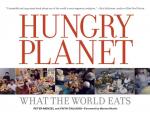|
This section contains 534 words (approx. 2 pages at 400 words per page) |

|
Hungry Planet: What the World Eats Summary & Study Guide Description
Hungry Planet: What the World Eats Summary & Study Guide includes comprehensive information and analysis to help you understand the book. This study guide contains the following sections:
This detailed literature summary also contains Topics for Discussion on Hungry Planet: What the World Eats by Peter Menzel.
"Hungry Planet: What the World Eats" by Peter Menzel and Faith D'Aluisio offers a photographic study of families around the world. It details what each family eats during a week and gives a family profile. The book goes into depth describing food options and purchases.
In Australia, two families have different eating experiences. The Browns of Riverview once lived in the outback where they survived on lamb, porcupines, and kangaroo. The other family highlighted is the Malloy family. They enjoy barbecuing out by the pool when the weather is hot. Since they live close to Asia, they enjoy some Asian cuisine. Once a week they have nibble food, and once a week they have fast food for dinner.
In Bhutan, the Namgays live in a steady diet of food with chili pepper added. They think that this is a vegetable. The village people work together to make sure everyone is fed. In Bosnia, the Dudos family struggles to survive after a civil war. They are better off than others since they have a vegetable garden, fruit trees, and a well. Over in Chad, things are even more difficult. They people struggle to get basic nutrition and water.
In China, traditional foods sit in the cupboards next to modern, international fare. Families grow foods on land given to them by the government. They purchase other foods by trading or with cash. In Cuba, the families are given food ration booklets that they use to get food, which provides 1/3 to 1/2 of their monthly diet. The rest of their food comes from markets. In Ecuador, food also comes from markets, since it's difficult to grow anything in the harsh climate.
In Egypt, women spend a lot of time preparing stuffed, spicy food. This is in contrast to France where fast food seems to be taking over traditional French meals. In Germany, large supermarkets take over local markets because their prices are more economical.
Food based on convenience is also prevalent in Great Britain, but the family highlighted is leaning toward a vegetarian diet. This is different from the family in Greenland who uses a dogsled to travel over two hours to the store. They hunt for their food. Like the family in Great Britain, the people in Guatemala have a mostly vegetarian diet. They eat meat less than once a week, but unlike the Great Britain family, their sweets are bananas, not processed foods.
In India, the food is centered around vegetables. Hindus are vegetarian, and the family highlighted is Hindu. Over in Italy, there is a wide variety of foods in the market. The diet includes fresh vegetables and fish as well as lots of pasta. In Japan, the younger generation is drawn to fast foods as they are in Okinawa, but in Okinawa, everyone gathers for traditional fare on weekends. Kuwait food name brand foods and lamb. Their land is poor for growing. In Mali, families eat various forms of porridge.
Food is difficult to obtain in poverty-stricken areas such as Mexico, Mongolia, the Philippines, Poland, and Turkey. However, places such as the United States have such easy access to fast food and processed foods and obesity is a serious issue.
Read more from the Study Guide
|
This section contains 534 words (approx. 2 pages at 400 words per page) |

|



